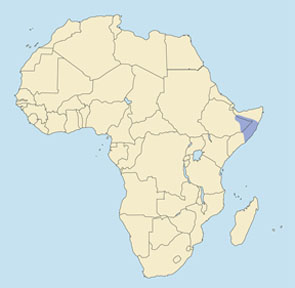 |
Ammodorcas clarkei
Antilope de Clarke (Sp), Dibatag, Lamagazelle (G), Dibatag, Gazelle de Clarke (F).
"Dibatag" is from the Somali dabu (tail) and tag (erect), in reference to the way it carries its tail. Sometimes called Clarke gazelle after sportsman T. W. H. Clarke, its Western discoverer in 1890.
DESCRIPTION Shoulder height 32-35 inches (81-89 cm). Weight 65-70 pounds (29-32 kg).
The dibatag is a small, graceful antelope with a long, slim neck and long legs. It resembles a gazelle except for its reedbuck-like horns, its long tail, and its foot structure. The overall color is purplish gray tinged with cinnamon. The underparts and rump are white. The face has a reddish blaze in the center, white and dark stripes on the sides, and white around the eyes. The tail is very long, thin and entirely black, and is held erect when the dibatag is alarmed, or arched forward over its back when it runs. The horns (males only) somewhat resemble those of a reedbuck. They are deeply ridged at the base, growing upward, backward and forward in an even curve. Females are similar, but smaller and hornless.
BEHAVIOR Usually lives in pairs or groups of 3-5, but sometimes is solitary, or in larger family groups. May be in loose association with other species such as Soemmerring gazelle, gerenuk or (formerly) Swayne hartebeest. Breeding takes place year-round, but seems to peak during the rainy season. One young is born after 6-7 months gestation, thus two births a year are possible.
Active early and late, resting during the midday heat. A browser, its long neck allows it to feed in trees, often standing on its hind legs. It also grazes to some extent. Can survive without free water. Hearing and sense of smell are very good, eyesight less so. Very shy and alert. Remains motionless until discovered.
HABITAT Low thornbush and grassy patches.
DISTRIBUTION East of the Webi Shebeli River in southeastern Ethiopia and central Somalia. Formerly widespread in the Haud of northern Somalia, but no longer found there.
REMARKS Mellon says of it: "The dibatag has everything. His hearing, vision, and sense of smell are all excellent. He is shy, sharp-witted, ingeniously camouflaged, and unsurpassably beautiful in both motion and repose. No other Somali game animal is so elegant or so cunning. In fact, few mammals anywhere are in a class with the dibatag."
It is protected by law, although said to be heavily poached by local residents.
TAXONOMIC NOTES No subspecies are recognized.
STATUS Listed as endangered by the USF&WS (1970). However, Hillman (1988) considered its status probably satisfactory in Ethiopia, with numbers unknown but believed to be stable. Simonetta (1988) regarded it as indeterminate in Somalia, where its numbers have dropped because of poaching, drought and overgrazing by domestic livestock. Has lost about half its Somali range, although mainly in areas where it was not common anyway.
|





